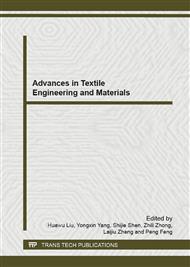[1]
L. Jizhen, F. Xuezhong, F. Xiping, et.al. Journal of Thermal Analysis and Calorimetry Vol.85(2006), pp.779-784.
Google Scholar
[2]
Z. Lin, X. Han, T. Wang, et al. Journal of Thermal Analysis and Calorimetry,Vol. 91(2008),pp.709-714.
Google Scholar
[3]
X.X. Jian, L.Q. Xiao, W.L. Zhou. Polymer Bulletin, Vol. 93(2009), pp.225-233.
Google Scholar
[4]
S.N. Li, Y. Liu, X.L. Tuo, et.al. Polymer, Vol. 49(2008), pp.2775-2780.
Google Scholar
[5]
T.T. Alekseeva, Yu.S. Lipatov, N.V. Babkina, et al. Polymer, Vol. 46(2005), pp.419-428.
Google Scholar
[6]
L.H. Sperling. Interpenetrating polymer networks and related materials( New York: Plenum,1981).
Google Scholar
[7]
Yu.S. Lipatov, T.T. Alekseeva, L.F. Kosyanchuk.et al. Polymer, Vol. 40(1999), pp.7083-7087.
Google Scholar
[8]
Yu.S. Lipatov , T.D. Ignatova, L.F. Kosyanchuk,et al. European Polymer Journal, Vol. 43(2006), pp.3102-3107.
Google Scholar
[9]
A.E. Nesterov , Y.S. Lipatov, T.D. Ignatova. European Polymer Journal, Vol. 37(2001), pp.281-285.
Google Scholar
[10]
A.E. Nesterov, Y.S. Lipatov. Polymer, Vol. 40(1999), pp.1347-1349.
Google Scholar
[11]
Y.S. Lipatov, A.E. Nesterov ,T.D. Ignatova,et al. Polymer, Vol. 45(2002), pp.875-880.
Google Scholar
[12]
N. V. Babkina, Yu. S. Lipatov, and T. T. Alekseeva. Mechanics of Composite Materials, Vol. 42(2006), pp.385-392.
Google Scholar
[13]
Yu. P. Gomza, V. V. Klepko, Yu. S. Lipatov, Polymer Science Series A, Vol. 50(2008), pp.956-964.
Google Scholar
[14]
N. V. Babkina, Yu. S. Lipatov, T. T. Alekseeva.et al. Polymer Science Series A, Vol. 50(2008),pp.798-804.
Google Scholar
[15]
M. S. Sánachez, G.G. Ferrer, C.Torregorosa. Polymer, Vol. 42(2001),pp.10071-10075.
Google Scholar
[16]
D. J. Hourston, F.U. Schäfer, J. S. Bates, et al. Polymer, Vol. 39(1998),pp.3311-3320.
Google Scholar
[17]
Y. X. Pang, D. M. Jia, H. J. Hu, et al. Polymer,Vol. 41(2000), pp.357-365.
Google Scholar
[18]
T. Trakulsujaritchok, D.J. Hourston. European Polymer Journal, Vol. 42(2006), pp.2968-2976.
Google Scholar
[19]
J.M. Chenal, J.M. Widmaier. Polymer, Vol. 46(2005),pp.671-675.
Google Scholar
[20]
M.salmerón Sánchez, G.Gallego Ferrer, C.Torregrosa Cabanilles. et,al. Polymer, Vol. 42(2001),pp.10071-10075.
Google Scholar
[21]
H.Kumar, A.Anil Kumar, Siddaramaiah. Polymer Degradation and Stability, Vol. 91(2006),pp.1097-1104.
Google Scholar
[22]
Y. S. Lipatov. T. T. Alekseeva. Adv Polym Sci ,Vol.208(2007), pp.14-22.
Google Scholar


